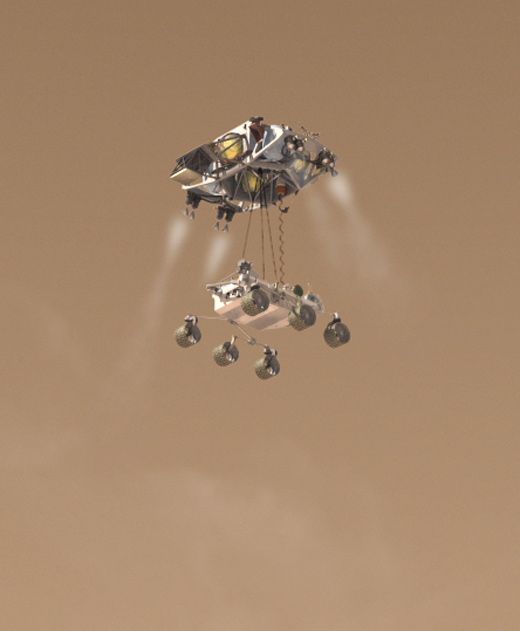Legs, Bags, or Wheels?
When choosing landing gear for Mars spacecraft, engineers have to weigh their options-literally.
/https://tf-cmsv2-smithsonianmag-media.s3.amazonaws.com/filer/msl-388-aug07.jpg)
Say goodbye to airbags, at least for now. The next visitor to Mars, the Phoenix lander (see “Northern Exposure,” August 2007), will touch down on the planet the old-fashioned way—on legs.
NASA’s last three Mars landers, Pathfinder, Spirit, and Opportunity, all parachuted to the ground inside a cluster of tough fabric airbags that absorbed the shock of impact. After cutting loose from the parachute, the airbags bounced, rolled to a stop, and deflated, and out came the rovers.
However cool they might be (if only we had video of Spirit’s 27-foot-high first bounce on Mars), airbags have disadvantages. The bags and their supporting hardware are themselves heavy, which reduces the amount of scientific equipment a lander can carry. And for precision landings, legs generally do a better job. Spirit bounced 28 times before finally settling to a stop 300 yards from its point of first impact.
On the other hand, airbags aren’t bothered by large rocks that might tip a legged lander. On the other other hand, spherical airbags can roll into a deep crater from which a rover would never escape. It’s all about tradeoffs. When choosing a landing system for Mars, engineers consider many factors, down to the location of the target site (lower elevations give the parachute more float time to slow the spacecraft in the thin atmosphere).
The Viking landers of the 1970s touched down on three “crushable” legs—technology borrowed from the moon landers of the previous decade. By the time the smaller Pathfinder returned to Mars in 1996, however, NASA was into saving money, and airbags were selected as a cheap, clever alternative.
The Phoenix spacecraft, originally built for a 2001 Mars mission that was subsequently canceled, uses a lightweight landing system developed for the Mars Polar Lander, which didn’t get the chance to try it: In 1999 a software error caused the spacecraft to crash onto Mars. Phoenix, which weighs about the same as Spirit and Opportunity, would have been light enough to use airbags, but its landing system was designed before Pathfinder proved that bags really work. So legs are back in style, at least temporarily. Next May, after the three-legged Phoenix separates from its parachute at an altitude of 3,300 feet, pulsed rocket engines underneath the spacecraft will fire, slowing Phoenix to 5.5 mph at touchdown. The rockets will fire until the lander makes contact.
Next up is the Mars Science Laboratory, due to launch in 2009. The MSL represents a giant leap for rover-kind. While the golf-cart-size Spirit weighs about 350 pounds, the 2009 rover will be four and a half times as heavy, and as big as a MINI Cooper. Scientists also expect to set it down with pinpoint precision to maximize their chances of finding interesting geology.
That poses quite a challenge for the engineers at NASA’s Jet Propulsion Laboratory in Pasadena, California, who, after tossing out other options, came up with a new kind of Mars landing system based on the Skycrane heavy-lift helicopter, the Sikorsky CH-54B. (You can see an animation of this planned Skycrane maneuver here). Instead of placing rockets on the spacecraft itself, as has been done with all past Mars landers, the engineers put them on a descent stage, which resembles a flying bedstead. The rover, slung underneath the hovering descent stage, is lowered to the ground on cables and touches down on six wheels. Then it drives off. No bags, no legs, no worries.
At first the JPLers weren’t convinced a Skycrane-style landing, which looks precarious, would be controllable. But they watched videos of helicopters nimbly moving around large construction equipment, invited a Skycrane pilot to sit in on one of their engineering review boards, and of course did lots of ground testing to verify that the MSL system will work. As a bonus, the touchdown will be gentler: The rover’s wheels will hit the ground at a mere three feet per second, compared to eight feet per second for the Phoenix landing.
If the Skycrane maneuver works, it may become the landing technique of choice as NASA sends even heavier spacecraft to Mars. But that doesn’t necessarily mean the end of airbags. The engineers behind Europe’s ExoMars mission, due to launch in 2013, are leaning toward using a new kind of “vented” donut-shaped airbag that recently performed well in ground tests in Italy. The Spirit-size ExoMars rover would be ensconced in the middle, and the donut would plop down on the surface like a beanbag, then instantly deflate.
Even though vented airbags are an old idea, as with many technologies for exploring Mars, they haven’t yet been tried. And when it comes to the make-or-break landing system, spacecraft engineers don’t like to take chances. From the time the spacecraft enters the atmosphere to the moment of touchdown, a Mars landing takes just a few minutes. There’s often no redundancy in the hardware, and with TV cameras in the control room, there’s no place for mission managers to hide if things go wrong. Wish them all luck.
